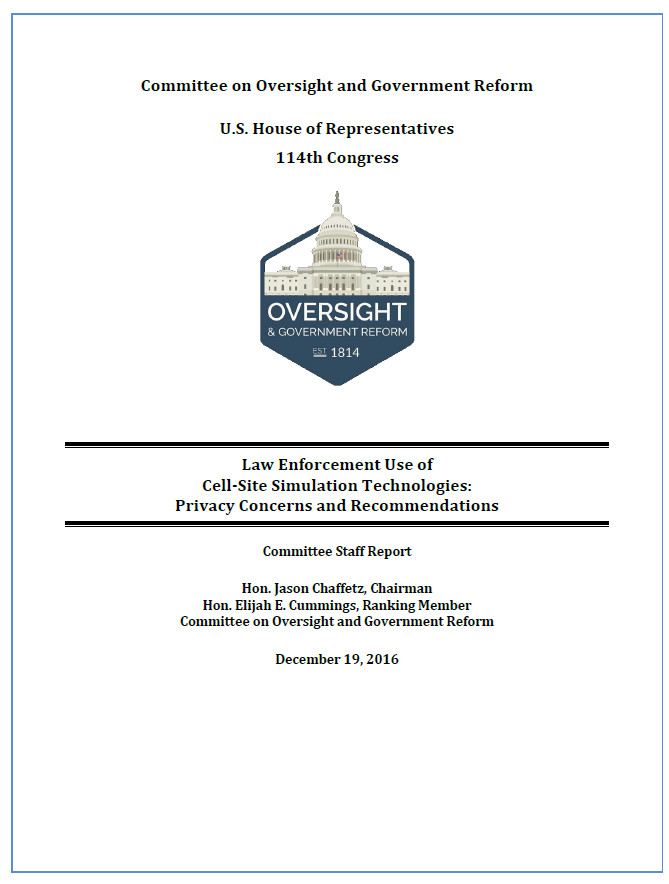Advances in emerging surveillance technologies like cell-site simulators – devices which transform a cell phone into a real-time tracking device – require careful evaluation to ensure their use is consistent with the protections afforded under the First and Fourth Amendments to the U.S. Constitution.
The United States’ military and intelligence agencies have developed robust and sophisticated surveillance technologies for deployment in defense against threats from foreign actors. These technologies are essential to keeping America safe.
Increasingly though, domestic law enforcement at the federal, state, and local levels are using surveillance technologies in their every-day crime-fighting activities. In the case of cell-site simulators, this technology is being used to investigate a wide range of criminal activity, from human trafficking to narcotics trafficking, as well as kidnapping, and to assist in the apprehension of dangerous and violent fugitives.
Law enforcement officers at all levels perform an incredibly difficult and important job and deserve our thanks and appreciation. While law enforcement agencies should be able to utilize technology as a tool to help officers be safe and accomplish their missions, absent proper oversight and safeguards, the domestic use of cell-site simulators may well infringe upon the constitutional rights of citizens to be free from unreasonable searches and seizures, as well as the right to free association. Transparency and accountability are therefore critical to ensuring that when domestic law enforcement decide to use these devices on American citizens, the devices are used in a manner that meets the requirements and protections of the Constitution.
After press reports alleged wide-spread use of cell-site simulation devices by federal, state, and local law enforcement, the Committee initiated a bipartisan investigation in April 2015. At the outset of the investigation, the use of these devices by federal, state, and local law enforcement agencies was not well known, and in many instances, appeared to be shrouded in secrecy. This is partly due to the use of the technology by military and intelligence agencies and the need for sensitivity in national security matters. The Federal Bureau of Investigation (FBI), for example, avoided disclosing not only its own use of the devices, but also its role in assisting state and local law enforcement agencies in obtaining and deploying these devices. Indeed, the Committee’s investigation revealed that as part of the conditions for being able to sell cell-site simulators to state and local law enforcement, the manufacturers of these devices must first notify the FBI, and those agencies in turn must sign a non-disclosure agreement with the FBI that expressly prohibits them from publicly disclosing their use of this technology, even in prosecutions where the use of the technology was at issue.
…
FINDINGS
- The Department of Justice has 310 cell-site simulation devices and spent more than $71 million in fiscal years 2010-14 on cell-site simulation technology.
- The Department of Homeland Security has 124 cell-site simulation devices and spent more than $24 million in fiscal years 2010-14 on cell-site simulation technology.
- DHS allows state and local law enforcement to purchase cell-site simulation technology using grants from the Preparedness Grant Program administered by the Federal Emergency Management Agency (FEMA), including the State Homeland Security Program, Law Enforcement Terrorism Prevention Program, Citizen Corps Program, Urban Areas Security Initiative, Emergency Management Performance Grants, Buffer Zone Protection Program, Transit Security Program, and the Intercity Passenger Rail Program.
- DHS was able to identify more than $1.8 million in grant money to state and local law enforcement to purchase cell-site simulation technology, however DHS does not maintain a separate accounting of grant funds used to purchase cell site-simulators and the total amount may be higher.
- Before DOJ and DHS issued their new and enhanced policies for the use of cell-site simulators—which now require a warrant supported by probable cause—federal law enforcement agencies had varying policies and most relied on a lower-than-probable cause standard for use of these devices in most, but not all, situations.
- State laws continue to vary as to what court authorization is required before law enforcement can deploy cell-site simulators. Several states, including California, Washington, Virginia, Utah, and Illinois have passed laws requiring law enforcement agencies to obtain a warrant or order based on probable cause before deploying cell-site simulators, with varying exceptions.
- In many cases, state and local law enforcement continue to rely on the state equivalent of a pen register/trap and trace order, which only requires law enforcement to meet a “relevance based standard” to use cell-site simulation devices, a standard lower than probable cause.
- Costs of individual cell-site simulator devices ranged from $41,500 to as high as $500,000.

